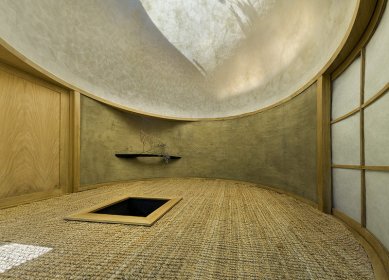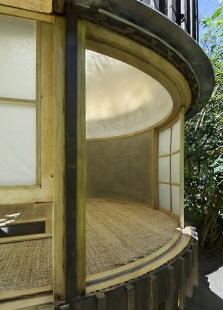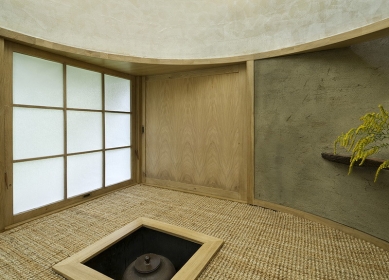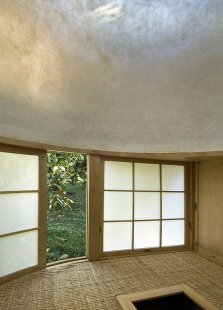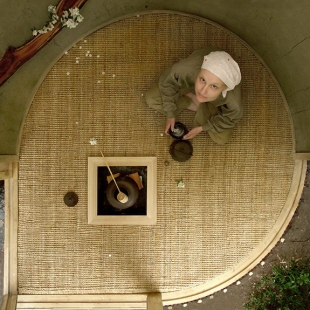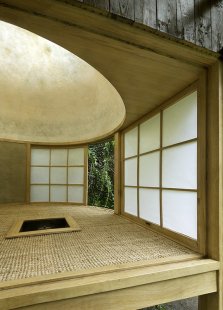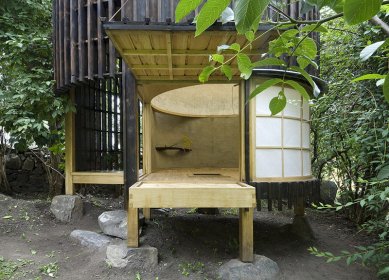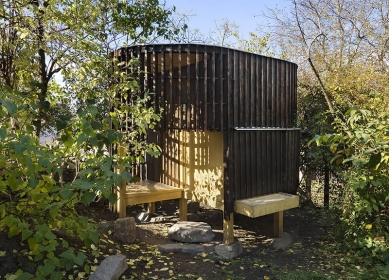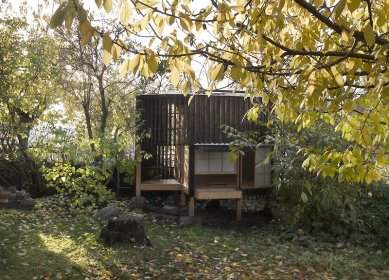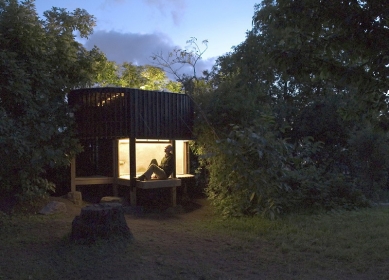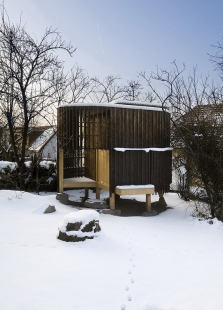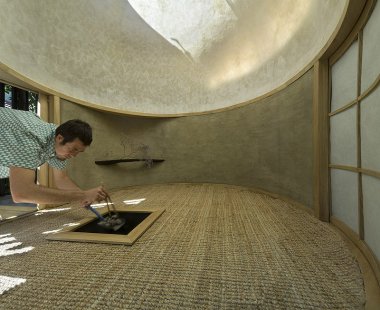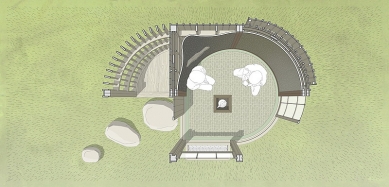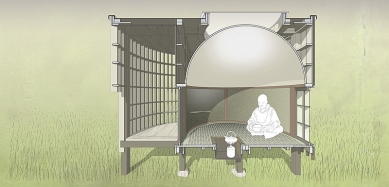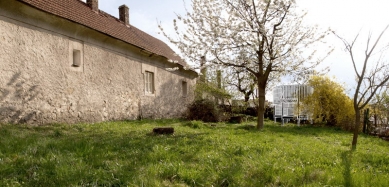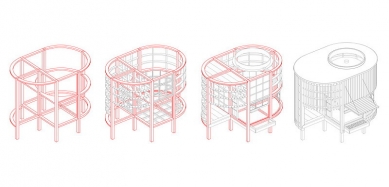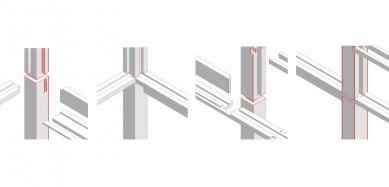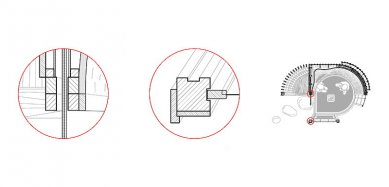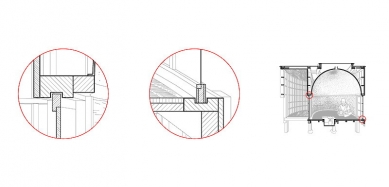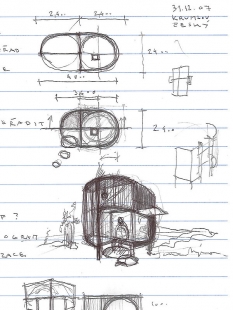
Tea house in the garden
minimum space for a meeting

GARDEN
At the foot of the hill that separates Hloubětín from Aloisov, you will find a small garden. The garden is inconspicuous, somewhat wild, yet charming; every spring, a cherry tree and several fruit trees bloom here, and in the summer, the view of the clouds is framed by blades of grass. Where else to build a tea house than in a garden that offers a pleasant refuge under the shade of golden rain.
TEA HOUSE AS A MINIMAL SPACE FOR MEETING
The tea house as a typological type draws on the Japanese tradition of spatial minimization and is intended for meeting with guests over a cup of tea. Personally, I am not at all an orthodox follower of the tea cult, but I am interested in the theme primarily as a search for a minimal space where I can meet friends, and besides that, I love tea. The outwardly inconspicuous building offers an unexpected surprise inside, providing guests with a different perspective on the surrounding garden. Inside, there is a world where time flows at its own pace, an empty space that impresses with its very spaciousness. While thinking about such a place, I first organized memories of buildings that left an impression on me, and after some time, a circular floor plan emerged in my sketches, topped with a translucent dome reminiscent of the inner peace of small sacred buildings. Diffused light enters the space from above, and the translucent dome creates a sky that also serves as a projection surface for the shadow play of the leaves of the elderberry leaning over the tea house. The circle directs the guests' attention to the hearth where the tea is prepared, creating a close bond among all present. My vision is a personal interpretation of the tea house, which in many respects differs from traditional and contemporary buildings of this type.
NATURAL MATERIAL
The interior walls consist largely of windows overlooking the garden, and the other half is ordinary colored clay plaster. Guests settle on a jute mat, and the tea is prepared on a hearth made of black steel. The inner dome is laminate glued with paper, through which light enters from above, pleasantly modeling the interior space.
MINIMAL SPACE FOR MEETING
The tea house serves for meetings with guests. With the invitation itself, a tense moment and expectation arise when we want to offer guests a pleasant experience. The moment everything is carefully prepared, the meeting occurs, during which we share our presence, impressions, and experiences—our shared closeness. I believe that this moment cannot be better captured by anyone other than the master Sen no Rikyuu himself:
The house and the dewy ground
The guest and the host
Sip tea together
In quiet contemplation
In spiritual harmony
CONSTRUCTION AND BUILDING
The carpentry-bound oak structure stands on stones from a nearby pond. The burnt larch cladding creates a mimicry of the building in the garden, as the focus of the meeting is concentrated on the inner world that one reveals only after entering. The master of the construction is Vojta, with whom we built the structure together, just the two of us, from dawn to dusk over 35 days in April and May 2008.
CONCLUSION
Just as the realization with Vojta was incredible, the meeting with Professor and architect Terunobu Fujimori during our two-month journey in Japan in 2007 was also remarkable, but especially his visit during the construction right in our garden in May 2008. I hope that we can offer him a meeting in the already finished house during his next trip to Europe.
Client: David Maštálka and Lenka Křemenová
Author: MgA. David Maštálka / A1ARCHITECTS
Master Builder: MgA. Vojtěch Bilišič (Slovak Republic)
Collaboration: Lenka Křemenová, Marta Maštálková, Milan Maštálka, Rudolf Maštálka, Honza Bašta - master of domes
Opponent: Prof. arch. Terunobu Fujimori, University of Tokyo (Japan)
Interpreting: Petr Holý - Director of the Czech Center in Tokyo
Translations: Namiko Sakamoto
Photography: MgA. Ester Havlová
Costs: approx. 135,000 CZK
Area: approx. 3.75 m²
Realization: 35 days in April and May 2008
At the foot of the hill that separates Hloubětín from Aloisov, you will find a small garden. The garden is inconspicuous, somewhat wild, yet charming; every spring, a cherry tree and several fruit trees bloom here, and in the summer, the view of the clouds is framed by blades of grass. Where else to build a tea house than in a garden that offers a pleasant refuge under the shade of golden rain.
TEA HOUSE AS A MINIMAL SPACE FOR MEETING
The tea house as a typological type draws on the Japanese tradition of spatial minimization and is intended for meeting with guests over a cup of tea. Personally, I am not at all an orthodox follower of the tea cult, but I am interested in the theme primarily as a search for a minimal space where I can meet friends, and besides that, I love tea. The outwardly inconspicuous building offers an unexpected surprise inside, providing guests with a different perspective on the surrounding garden. Inside, there is a world where time flows at its own pace, an empty space that impresses with its very spaciousness. While thinking about such a place, I first organized memories of buildings that left an impression on me, and after some time, a circular floor plan emerged in my sketches, topped with a translucent dome reminiscent of the inner peace of small sacred buildings. Diffused light enters the space from above, and the translucent dome creates a sky that also serves as a projection surface for the shadow play of the leaves of the elderberry leaning over the tea house. The circle directs the guests' attention to the hearth where the tea is prepared, creating a close bond among all present. My vision is a personal interpretation of the tea house, which in many respects differs from traditional and contemporary buildings of this type.
NATURAL MATERIAL
The interior walls consist largely of windows overlooking the garden, and the other half is ordinary colored clay plaster. Guests settle on a jute mat, and the tea is prepared on a hearth made of black steel. The inner dome is laminate glued with paper, through which light enters from above, pleasantly modeling the interior space.
MINIMAL SPACE FOR MEETING
The tea house serves for meetings with guests. With the invitation itself, a tense moment and expectation arise when we want to offer guests a pleasant experience. The moment everything is carefully prepared, the meeting occurs, during which we share our presence, impressions, and experiences—our shared closeness. I believe that this moment cannot be better captured by anyone other than the master Sen no Rikyuu himself:
The house and the dewy ground
The guest and the host
Sip tea together
In quiet contemplation
In spiritual harmony
CONSTRUCTION AND BUILDING
The carpentry-bound oak structure stands on stones from a nearby pond. The burnt larch cladding creates a mimicry of the building in the garden, as the focus of the meeting is concentrated on the inner world that one reveals only after entering. The master of the construction is Vojta, with whom we built the structure together, just the two of us, from dawn to dusk over 35 days in April and May 2008.
CONCLUSION
Just as the realization with Vojta was incredible, the meeting with Professor and architect Terunobu Fujimori during our two-month journey in Japan in 2007 was also remarkable, but especially his visit during the construction right in our garden in May 2008. I hope that we can offer him a meeting in the already finished house during his next trip to Europe.
Client: David Maštálka and Lenka Křemenová
Author: MgA. David Maštálka / A1ARCHITECTS
Master Builder: MgA. Vojtěch Bilišič (Slovak Republic)
Collaboration: Lenka Křemenová, Marta Maštálková, Milan Maštálka, Rudolf Maštálka, Honza Bašta - master of domes
Opponent: Prof. arch. Terunobu Fujimori, University of Tokyo (Japan)
Interpreting: Petr Holý - Director of the Czech Center in Tokyo
Translations: Namiko Sakamoto
Photography: MgA. Ester Havlová
Costs: approx. 135,000 CZK
Area: approx. 3.75 m²
Realization: 35 days in April and May 2008
The English translation is powered by AI tool. Switch to Czech to view the original text source.
14 comments
add comment
Subject
Author
Date
v jednoduchosti je krása
juchytka
12.03.09 08:59
really nice piece
jmcouffin
12.03.09 09:21
Poděkování
Jiří Thiemel
12.03.09 09:45
radůstka
Vích
12.03.09 10:31
Pro radost
Pavla Grünerová
12.03.09 11:35
show all comments






